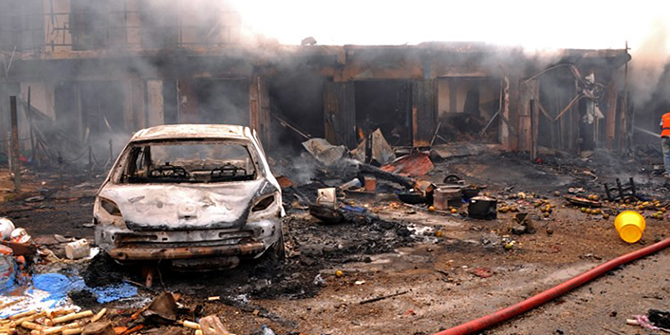LSE’s Ilaria Carrozza says that the book Border and Borderlands as Resources in Horn of Africa addresses a gap in Africanist Studies on the impact of human agency on the limitations imposed by borders.
Border and Borderlands as Resources in the Horn of Africa provides an interesting counter-intuitive view of states borders as resources for people who live along them. It is somehow difficult to frame this volume into a specific academic field, as it simultaneously draws from several fields of knowledge, including human geography, history, political science and social anthropology. And perhaps, there is no need for any labelling, as it is purposely interdisciplinary in its approach.
The main aim of the book is to offer an alternative view of borders and borderlands to most of the literature, which typically perceives them as constraints and barriers. Instead, the editors argue, borders can also represent a resource. Through this non-judgmental (the editors claim) perspective, they chose to deal with a region like the Horn of Africa that is, more than others, conflict-prone – and most of the blame for these conflicts has traditionally been put on arbitrary colonial borders. Challenging this vision, as well as globalisation theory which argues for the irrelevance of borders, authors in the volume consider the latter as ‘far from irrelevant’ (p. 21).
What emerges clearly from the analysis – and which is too often forgotten in the literature – is a focus on human agency. What matters to the authors is not as much the limitations that borders put on people, as ‘what the people have done to the borders’ (p. 11). Indeed, the volume explicitly addresses a research gap in Africanist studies as to how people adapt to state borders and how they use them. In this regard, Feyissa and Hoehne identify four different kinds of resources that people can extract from state borders and borderlands: economic resources; political resources; identity resources; and status and rights resources.
What most of the case studies presented here have in common is that they provide accurate empirical accounts of the social and material processes that shape borders. The opportunities provided by borders, in fact, are not given but rather require efforts from the part of local actors. Thus, for example, Feyissa’s case study deals with the making of the Ethio-Sudanese Border which is underlined by an interest in everyday forms of state formation that points to the political competition between the Anywaa and the Nuer communities.
Adugna argues for the advantages of the Ethio-Kenyan border in post-colonial times as a resource to overcome competition and conflict through the use of kin connections. Through the case of the Tigrinnya-speakers living across the border between Eritrea and Ethiopia, Smidt shows that the existence of such a border is a very part of their larger ethno-regional group, and suggests that the view on the illegitimacy of the Ethiopian boundaries is mistaken.
Yasin maintains that support among kin groups facilitated the transformation of the conflict between the Afar and Issa-Somali into a political dispute over territory, where the two ethnic groups try to take advantage of cross-border relations as best as they can. Hoehne shows some of the opportunities for local populations living across the border between Somaliland and Puntland, while Barnes deals with the history of the Ethiopian-British Somaliland border during colonial times, arguing that the choice between territorial administrations was a calculation that took into account household interests as well as the strength of Somali clans. Furthermore, Cassanelli makes the point of how a dynamic frontier economy across the Somalia-Kenyan border, constituted by cross-border alliances, financial networks and commercial mechanisms, contributed to the growth of several sectors in both countries’ economies. Wekesa’s analysis of the Kenya-Uganda border led him to argue that patterns of inter-state policy have facilitated the emergence of vibrant informal economic activities as a viable survival option among the two communities of Babukusu and Bagisu. Finally, Declich provides the example of how the Somali Zigula who live in the Juba region have ignored modern national frontiers and instead focus on cultural similarities as more important.
In conclusion, Feyissa and Hoehne point to how the case studies analysed show evidence of how state borders in the Horn of Africa, despite being arbitrary and often imposed through the use of force, can nonetheless provide opportunities for the people living around them. However, while a latent optimism seems to underlie most of the book, the conclusions are direr: when addressing the question of whether interactions alongside borders are not just a compensatory mechanism to earn local populations some sort of consolation prize, they present a less optimistic scenario. While, they argue, in the case of the economic resources, it is easier to conclude that frontiers are of higher benefit to states than local populations, the politics of borderlands is more problematic and nuanced. In fact, political pressures have led to a process of fragmentation – either by establishing new sovereign states or by drawing new internal borders – of which the consequences are yet to be seen. The only straightforward aspect to emerge from the analysis is the instrumental nature of borders, which are constantly being taken advantage of by ‘opportunist entrepreneurs’ (p. 192).
I would recommend reading the book to anyone who is interesting in understanding the human interactions that revolve around borders, and I believe that the authors should be praised for the attempt to provide an alternative view of borderlands in a region such as the Horn of Africa where boundaries seem to be an ‘inescapable fact of life’ (p. 195).
Ilaria Carrozza is a researcher at LSE. Follow her on Twitter @ilaria_carrozza.
The views expressed in this post are those of the author and in no way reflect those of the Africa at LSE blog or the London School of Economics and Political Science.





